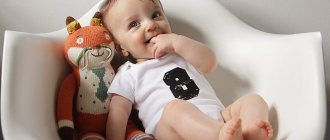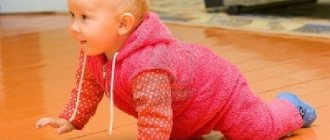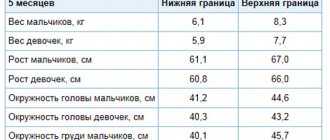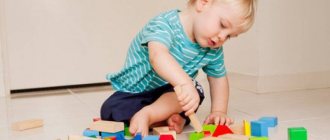There is a funny aphorism: “People’s mothers carry a child not for 9 months, but for 18: the first half of the term - in themselves, the second - on themselves.” Of course, babies remain “tame” for a longer time, but this humorous aphorism contains some truth. It is by 9 months that many children master the skill of crawling and are happy to hone it, going on an independent journey around the house in search of new experiences.
The diet is also expanding significantly: the baby’s menu after the introduction of fish includes almost all healthy foods from the adult table. What other achievements does a child enjoy at the “respectable” age of 9 months?
What can a 9 month old baby do?
- A baby at nine months sits up on his own and can easily sit for up to 10 minutes. From a sitting position he can reach and take a toy.
- Stands independently at a support, can take several small steps, follows a chair (holding the back of the chair, moves it and follows it). He can stay in a walker for up to 10 minutes without getting tired, jumping and squatting in it.
- The baby is trying to crawl. It is still difficult to get on all fours, but many children can crawl on their bellies. But if the baby can’t do it yet, don’t worry, just help him learn the skill.
- A child at 9 months increasingly uses pinching grip - he takes an object with two or three fingers, and can even pick up crumbs. Fine motor skills are actively developing, he sticks his fingers wherever he can, trying to touch everything. Knows how to tear paper into shreds.
- He confidently holds objects in his hands: pieces of food, a cup, but it is still difficult for him to unclench his fingers, so if the baby grabs something, it is extremely difficult to take it away from him. If you try to take away an object from your child, he will push your hand away and turn away.
- At 9 months, a child’s teeth continue or begin to grow, with all the accompanying phenomena (moody, drooling, temperature 37). Don’t worry if there are no teeth yet; normally, they can appear later and several can grow at once.
Read in detail: what a child can do at 9 months
Carefully! Active child!
At 9 months, children still cannot walk, but they are already making the house “shake up.” The ability to crawl allows the baby not only to conquer new heights by climbing on chairs and pillows, but also to open cabinets and get different objects. Fine motor skills are developed quite well, but the strength in the hands may not be enough, and therefore the beautiful vase taken will easily break. With this in mind, parents need to take precautions.
- It is necessary to remove any small objects from reach: buttons, beads, coins, candies, etc. The baby may put them in his mouth and choke.
- Close all lower cabinets or remove sharp, fragile and traumatic things from there: dishes, tools, knitting needles, sewing kit, etc. Instead, you can put towels, clothes or soft toys, because the baby likes to tinker with new things.
- It is better to lay oilcloth on the kitchen table rather than a tablecloth, since the baby can very easily pull on it.
- Sockets must be closed with special plugs.
- You need to hide all the documents and money, because the baby is already good at tearing paper.
To make the space around your child as safe as possible, you need to imagine yourself in his place: where would you like to climb, what to get and what to see? By predicting the actions of an active baby, you can easily remove all interesting but prohibited items from sight. In general, during the day the child happily plays with a bunch of his toys and watches the adults. Therefore, you can increase the time of daytime walks and begin to develop your child using play techniques.
What's new in psychological development
- A child's speech at nine months continues to develop at a rapid pace: he constantly repeats syllables, begins to link them into short words (dad, mom, baba) and associates them with objects. The child changes his intonation during the “conversation”.
- Knows his name, responds to it with a complex of animation: turns his head, smiles.
- A child’s emotions at 9 months become definite: he rejoices or laughs when he is made to laugh, and does not hide his resentment and anger when he is angry.
- He points his finger not only at those objects that he would like to get, but also where he would like to get into: he asks to open a cabinet, a refrigerator, to take something out of his pocket.
- Understands simple requests: “take this”, “come here”. Begins to master gestures: nods his head - “no” or “yes”.
- The child helps to dress himself: he puts his arms into the sleeves, pulls his leg into his trouser leg. He can take off his hat himself. He holds the cup with both hands and eats with his fingers.
- Playing hide and seek, he understands where you are, even if you are not visible. Can find by voice or rustle.
- Most often, he still uses toys for other purposes: he likes to hit one against the other, put them in each other, throw them and watch how they fall.
Baby development test at 9 months
- The baby should be able to sit without support, try to stand up, try to crawl after a toy, hold a cup in both hands;
- Lying on his tummy, he should reach for a toy and try to crawl;
- While sitting, the child should be able to turn around and grab an object from the side or slightly behind;
- Imitates your gestures and actions: show how to drum with sticks, the child should be able to repeat;
- When you try to take away a toy, the child should be able to prevent this: hold it tightly, pull it towards him;
- Repeated syllables must be present in the child’s speech;
- Must distinguish between loved ones and strangers, respond to his name.
The absence of any of the above skills should alert you. Be sure to consult your pediatrician about this.
How to feed a baby at 9 months
Continue to breastfeed or formula feed and introduce new foods to your complementary foods.
Breast milk (formula) should make up 1/4 of a child’s daily diet at 9 months. If you started feeding at 6 months, then you have replaced three breastfeedings and all the main products are present in the baby’s diet:
vegetable 150 -180 g and fruit purees 50 - 80 g, porridge up to 180 g, meat 50 g, yolk 1/2 twice a week, kefir and cottage cheese 30 - 40 g, crackers and wheat bread 5 g each, vegetable oil and butter 5 g, juice (fruit or vegetable) up to 80 g. Cottage cheese can be given with kefir in the evening feeding. In the ninth month, start introducing low-fat fish, about 50 g, once a week, as well as steamed meatballs. You can now make puree from several vegetables with the addition of herbs. Porridges can be made from a mixture of grains, including gluten (oatmeal, wheat), if well tolerated. It is better not to give semolina porridge until 1 year of age, as it is difficult to digest.
Height and weight
For the first six months, children grow literally by the hour, adding 2–3 cm in height and 700–900 g in weight every month. After the ninth month, the pace begins to slow down to 1.5 cm and 500 g per month, and the general physical characteristics of the child are within the following limits:
| WHO statistics | Statistics for the CIS | |||
| girls | boys | girls | boys | |
| Height (cm) | 67,5 – 76,5 | 65,3 – 75 | 68,2 – 75,1 | 67,5 – 74,1 |
| Weight, kg) | 7,1 – 11 | 6,5 – 10,5 | 7,9 – 10,5 | 7,5 – 9,7 |
| Chest circumference (cm) | 44 – 51,3 | 44 – 50,5 | 44,4 – 50,8 | 44,5 – 49,3 |
| Head circumference (cm) | 42,5 – 47,5 | 41,2 – 46,5 | 44 – 47,4 | 42,9 – 46,4 |
Mode: sleep and wakefulness
The child sleeps 2 times during the day for 2 hours, and at night - up to 10 hours. By this age, the daytime sleep pattern may change somewhat: since the baby began to sleep longer at night and wake up later, daytime sleep may shift somewhat. But many babies continue to sleep and play in the same mode.
Infants also wake up at night and ask for the breast, but not out of hunger, but out of a psychological need for closeness to their mother. Most likely, this will happen until you wean.
At this age, babies have problems sleeping. This is due to the fact that children can deliberately stretch their waking time as they want. They begin to understand that there is day and there is night, and everyone sleeps at night and plays during the day. Therefore, accustom your child to a routine, make sure that he does not get overtired with games.
READ ALSO: 9 month old baby's daily routine
How to help your child develop
Even if it's hard for you, continue to carry your baby in your arms. Before the baby walks, this is necessary for proper mental development.
Continue to develop your speech: talk to your baby, read picture books. Give preference to small poems and nursery rhymes in which words are repeated. Discuss the picture with your child, ask him to find something on it and point with his finger. Use themed cards with pictures. Make every effort to help your baby learn to crawl.
- Make a cushion out of the blanket and slide it under your baby's chest. Lifting the baby by the ends of the blanket, help him crawl to the toy;
- When a child tries to crawl, create support for his legs, first for one leg, then for the other. This way he will quickly master the cross-crawling technique;
- If your baby can already crawl, buy him a house with a tunnel. The child will surely be delighted, crawling from the house to the tunnel and back, and finding various surprises there. You can make a tunnel yourself from cardboard boxes;
- Show your little one how to build a tower from cubes or put together a pyramid. And although the baby himself will not yet be able to repeat this, it will be very interesting for him to watch how you do it. Perhaps he will try to put one cube on top of another or put a ring on a stick - this is also a step towards something new. Let the little one destroy the tower you built and make another one - let him break it. At this age, kids like to watch things fall and crumble. Ask him to put the cubes into the box after the tower has fallen apart;
- It's time to introduce yourself to toilet paper! Show your child how it unwinds. He will happily begin to crumple, tear and scatter pieces of paper - a good workout for his fingers. You can also stick a piece of tape to a child’s palm, the baby will have fun tearing it off;
- Even if you have a boy, buy him a doll. The more the toy resembles a real child, the better. Place the baby doll in front of your child and show him where the nose, eyes, mouth and everything else are. Then ask to show where and what the doll has, and where the child has it;
- Continue playing in the bathroom: show your baby how to pour water from one glass to another;
- Pour cereal into a bowl and bury small toys in it. Invite your child to find them in the cereal with his hand;
- Get your child a chest with small objects made from different materials, you can put in it: a piece of linoleum, scraps of different fabrics (silk, flannel, wool), cardboard, a bottle cap, a sponge, in general, anything that is safe. Let the baby experience tactile sensations;
- Continue playing "Ladushki", turn on children's songs or funny music, clap your hands together to it;
- At 9 months, a child can crawl and sit, so you can complicate many exercises for him, introduce gymnastic equipment into his classes: a ball, a wooden stick, plastic rings.
For a child in the ninth month, communication in play is very important.
Make sure that in the kitchen and in the rooms there is a set of items that you can give your baby to play with. You can come up with activities for your child yourself, perhaps he himself will tell you what he would like to play with his actions. Allow your baby to start the game himself, so you will teach him to be independent and teach him to make decisions.
← 8 month 10 month →
Physical development
During the 9th month, children on average become heavier by 500 g and grow by 2 cm. As a result, the weight is 7.5-10.5 kg, and the height is 67-76 cm. By nine months there are usually 4 teeth - 2 upper ones and lower incisors. However, their smaller number does not mean a developmental delay.
9-month-old babies sleep approximately 15 hours a day. 10-11 at night and 2 times for 2-2.5 hours during the day. At night they wake up less and less often, and night feedings may stop. The more active the baby is during the day and the calmer the evening, the better he sleeps at night . In the evening, bathe your child every day - not only for hygiene, but also to relieve daytime stress. You don't need a pillow until you're a year old.
At the 9th month, babies begin to crawl. First on the belly, then on all fours, quickly mastering active crawling in different directions. The little fidget doesn't like to be distracted from actively exploring the world, so sometimes you have to literally catch him to feed him, change his diaper, or dress him for a walk.
Nine-month-old babies can usually sit up independently from a lying position. Otherwise, you need to consult a doctor - a slight delay can be either normal or a manifestation of neurological disorders.
At this age, toddlers can already climb onto pillows and elevations, often kneel and stand on legs, holding on to support, stand and even try to jump, grabbing the bars of the crib. Kids are preparing to master the skill of walking. They can already stand with support from one hand, step with their legs while being held under the armpits. Walk at a side step along the support. If your baby has not yet learned these movements, do not be upset and do not push him: the child will get up and walk when he matures both physically and psychologically.
Children learn to pinch small objects with their index and thumb, find and present toys or other objects known to them, take out and transfer things between drawers and boxes, and begin to repeat the movements they have seen: clapping their hands, waving their hand goodbye.
Babies become very active and mobile, so one of the main tasks of parents is to secure the home and provide the baby with the opportunity and space to move: remove small and sharp objects from reach, cover wires and put plugs on sockets, lower the bottom of the crib. Do not leave him alone in a highchair, especially without seat belts - a nimble little one can shake the “throne” and fall out.










